Have you ever heard the word Omotenashi? It’s a unique aspect of Japanese culture that has recently garnered international attention. Known as a term representing the warm heart unique to the Japanese language.
But what exactly is Omotenashi? It has a deeper meaning than just polite service. In this article, we’ll explore the history, background, and modern examples of this Japanese Omotenashi.
What Exactly is Omotenashi?
According to dictionaries, Omotenashi has diverse meanings, including:
mediation, preparation, etiquette, behavior, conduct, attitude, treatment, entertainment, and reception.
What these words have in common is being considerate of others and treating them with heartfelt sincerity.
Omotenashi is the polite form of Motenashi, and its etymology includes the meaning of “accomplishing with things.” Here, “things” refer not only to tangible objects but also to the “heart” that thinks of the other person.
Furthermore, another origin of Omotenashi is the idea of “Omote-ura nashi,” meaning “no front or back”. This implies welcoming guests with an unpretentious and sincere heart.
In other words, Omotenashi consists of both material offerings and spiritual sincerity.
In training, responses to “What is Omotenashi?” include welcoming customers, creating kandō, and showing genuine care. These answers share a spirit of heartfelt preparation and sincere care to ensure others feel comfortable and genuinely welcomed.
This spirit means going beyond manuals to sensitively understand others’ feelings and respond with flexibility and care.
A survey by the Ministry of Land, Infrastructure, Transport and Tourism found that Japanese people value respect and consideration.
More Than Just Good Service
Omotenashi is distinct from mere etiquette or service. Manners avoid discomfort, service is paid, but Omotenashi is heartfelt, voluntary, and expects nothing in return. Western hospitality shows care openly, while Omotenashi uses subtle, quiet gestures to avoid making others feel self-conscious.
Omotenashi is rooted in Japanese tradition, shaping values in daily life and influencing behavior in the business world.
A Journey Through Time: The History of Omotenashi
The word Omotenashi traces its origins back to the Heian period. Motenashi appears in The Tale of Genji, showing people valued welcoming and caring for guests even in the Heian era.
Japanese Traditional Culture and Thought that Influenced the Spirit of Omotenashi
The spirit of Omotenashi did not emerge from a single culture or philosophy. Various Japanese traditional cultures and philosophies have influenced its underlying principles.
Tea Ceremony (Sado)
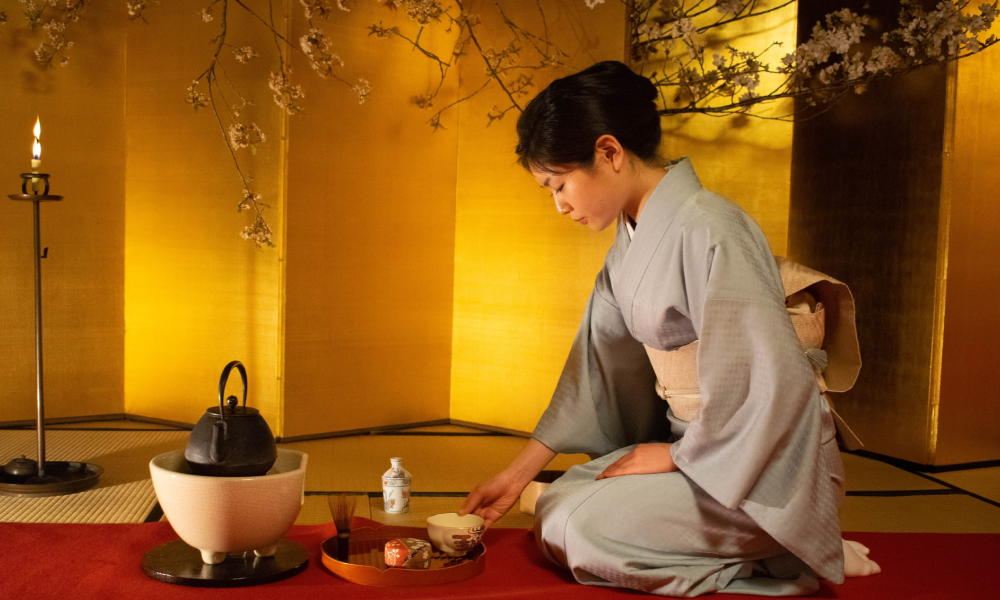
The tea ceremony (Sado) is one of the most representative Japanese traditional cultures that embodies the spirit of Omotenashi. In the tea ceremony, practitioners deeply value the concept of ichigo ichie—”one time, one meeting.” Each host-guest encounter is treasured as unique, with heartfelt sincerity and deep appreciation for the shared moment.
The host thoughtfully chooses decor, utensils, and prepares tea and meals to ensure the guest’s comfort and enjoyment. The host carefully adjusts timing, temperature, and tea quantity to help the guest relax and fully enjoy the experience.
The “Rikyu Seven Rules” advocated by Sen no Rikyu precisely demonstrate this spirit of Omotenashi.
The spatial arrangement in the tea ceremony also plays a key role in expressing Omotenashi. Hosts thoughtfully arrange everything from alcove decor to garden views to create a welcoming and delightful atmosphere for guests. Host and guest honor the moment together through thoughtful gestures and sincere gratitude, they create a shared, respectful experience. This spirit of mutual respect, where both create and enjoy the occasion together, lies at the heart of Omotenashi.
The tea ceremony, through detail and ichigo ichie, embodies and nurtures the spirit of Omotenashi in Japanese culture.
Martial Arts (Budo)
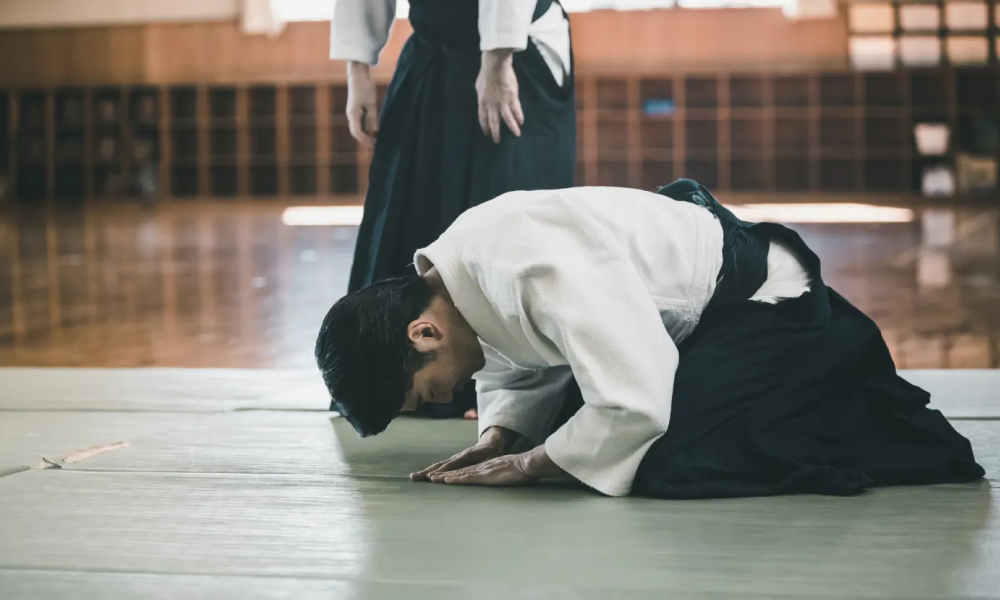
Budo is a general term for Japanese traditional martial arts such as Judo, Kendo, Kyudo, and Karate. Budo values etiquette deeply, emphasizing respect with the phrase: “begin with courtesy and end with courtesy.” Respect and fair play reflect Omotenashi, as all emphasize empathy, integrity, and thoughtful consideration for others.
The spirit of Budo includes a concept called zanshin. It reflects a mindset of readiness after action and ongoing respect for the opponent, aligning with Omotenashi values.
Budo closely reflects the spirit of Bushido (the way of the warrior), and its values of honor, respect, and etiquette have influenced the development of Omotenashi. These shared principles emphasize treating others with dignity and sincerity, even in moments of challenge or confrontation.
Budo aims for “human formation,” and cultivating the spirit through rigorous training, fostering politeness and perseverance, are important elements in nurturing the heart of Omotenashi.
Furthermore, the idea in Judo of respecting the opponent, cooperating, and helping each other to improve together is a spirit similar to the consideration for others in Omotenashi.
Shinto
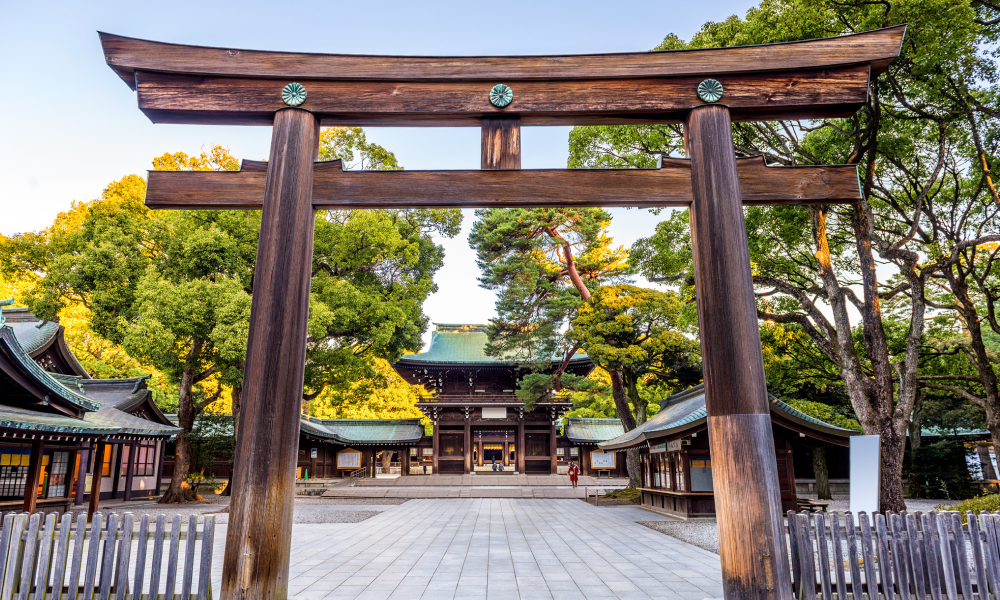
Shinto is an indigenous religion of Japan based on nature worship and has deeply influenced Japanese culture and national character.
In Shinto, the belief that gods reside in nature fosters a deep sense of awe and reverence toward the natural world. This respect naturally extends to human relationships, nurturing a mindset that values others and treats guests with care.
Shinto also emphasizes gratitude toward the gods, a teaching that closely aligns with the spirit of Omotenashi. This feeling of thankfulness inspires a sincere desire to welcome guests warmly and bring them happiness.
Shrines are not only places to enshrine gods but also serve as spiritual homes for people, playing a role in deepening the connections of local communities through various festivals and events. This spirit of valuing community may have influenced elements such as consideration for others and cooperativeness in “Omotenashi.”
In ancient Japan, people believed that guests were sacred marebito and treated them with great reverence. This belief, deeply rooted in Shinto, helped shape the tradition of welcoming others with care and sincerity, laying the groundwork for the spirit of Omotenashi.
Buddhism

Buddhism is one of the religions that has greatly influenced Japan, and its teachings are deeply involved in the spirit of Omotenashi. The fundamental Buddhist concept of compassion, that is, the feeling of caring for all living beings and the wish to remove their suffering, deeply resonates with the spirit of consideration and empathy for others in Omotenashi.
The Buddhist concept of “emptiness” (sunyata) encourages one to remove preconceived notions and see others as they are, which is an important idea in providing Omotenashi tailored to each guest. The Buddhist concept of dependent origination (pratītyasamutpāda), which teaches that all things are interconnected, offers a perspective that deepens awareness of how one’s actions affect others. This understanding encourages behavior rooted in empathy and consideration, further reinforcing the spirit of Omotenashi.
The Buddhist principle of no-self (anatman), which encourages letting go of self-centered thinking, closely aligns with the heart of Omotenashi. By placing the happiness and comfort of others above personal interests, this mindset nurtures genuine, selfless hospitality.
The custom of saying “itadakimasu” (I humbly receive) before meals originates from the Buddhist idea of expressing gratitude for the lives of plants and animals, and this also shares the feeling of gratitude at the root of Omotenashi.
In this way, Buddhist teachings have played a significant role in shaping the spirit of Omotenashi, fostering values such as consideration for others, empathy, and gratitude.
Concrete Actions and Examples Demonstrating Omotenashi
The spirit of Omotenashi can be observed in various aspects of daily life and the business world in Japan, where thoughtful consideration and genuine hospitality are consistently demonstrated.
In Daily Life
In Japanese daily life, there are numerous actions and examples imbued with the spirit of Omotenashi. For example, in stores, staff greet customers with a bright and polite tone, saying “irasshaimase” (welcome). When a customer sits down, a warm or cool oshibori (wet towel) is provided depending on the season, and restaurants offer free water or tea.
When purchasing a product, it is carefully wrapped, and on rainy days, it is covered with a plastic bag to prevent it from getting wet, showing meticulous consideration. The service of putting a book cover on a purchased book at a bookstore is also one of the Omotenashi practices that impresses many foreign tourists.

Visitors to Japan often find themselves pleasantly surprised by the punctual operation of public transportation, the spotless condition of public restrooms, and the cleanliness of city streets, all seen as everyday expressions of Omotenashi. Small yet meaningful gestures, like taxi drivers automatically opening and closing doors for passengers, or locals not only giving directions but walking with lost visitors to their destination, serve as well-known and heartfelt examples of this uniquely Japanese hospitality.
A baker warning a customer who is about to eat their purchased bread outside to be careful of kites, and a chef at a restaurant adjusting the amount and number of dishes based on the customer’s appetite are also expressions of Omotenashi that consider the other person.
In the Business Scene
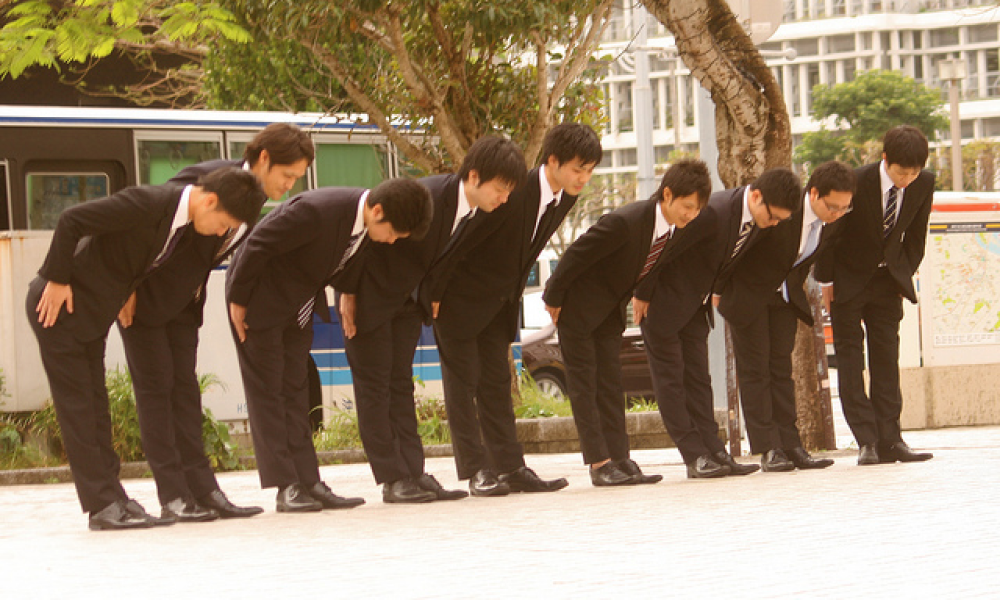
In the business scene as well, the spirit of Omotenashi is an important element. Providing services that exceed customer expectations and building long-term relationships of trust are important aspects of Omotenashi.
For example, an old-established restaurant preparing a foreign language menu with pictures of the dishes for overseas customers, and a clerk at an apparel shop remembering the preferences of a customer who made a purchase before and suggesting new items are examples of practicing Omotenashi.
Just as the honjin during the Edo period anticipated and accommodated the preferences of visiting daimyo, modern businesses emphasize the importance of analyzing customer data and past requests to deliver personalized services tailored to each individual.
Lexus, the luxury car brand of Toyota Motor Corporation, incorporates the spirit of Omotenashi as an important element of its brand image. The meticulous service of Japanese hotels and ryokan (traditional Japanese inns), and the on-time operation of Shinkansen (bullet trains) are also expressions of Omotenashi in business.
Even in everyday shops such as bookstores and hardware stores, the attitude of employees responding to customers with the spirit of Omotenashi can be seen. There are also examples of Japanese restaurants in America achieving success by providing Omotenashi to customers by greeting them in Japanese and recreating the atmosphere of Japanese stores.
Interpretation and Practice in Modern Society
In today’s globalizing world, the spirit of Omotenashi is attracting international attention as a unique aspect of Japanese culture. The word became widely known around the world after Ms. Christel Takigawa used it in her speech at the 2013 IOC General Assembly to promote Tokyo’s bid for the Olympics.
Abroad, people highly value Japan’s meticulous service and selfless hospitality, making Omotenashi a key factor in strengthening the brand appeal of the country’s tourism industry. This spirit of hospitality plays an essential role in traditional cultural experiences such as stays at ryokan, the refined artistry of kaiseki cuisine, and the elegance of the tea ceremony.
World-renowned luxury brands also emphasize exceptional service, or Omotenashi for their Japanese customers, resulting in high growth in the Japanese market. Thus, people around the world are re-evaluating Omotenashi not just as a part of Japanese culture, but as a concept with global relevance and strong international competitiveness.
Comparison with Service and Hospitality, and the Uniqueness of Omotenashi
People often translate Omotenashi into English as “hospitality,” but its meaning goes beyond simply treating others with kindness and courtesy. It reflects a deeper, more holistic consideration—even for details that guests may never notice. Service primarily aims to meet the customer’s requests and generally involves a fee, whereas Omotenashi emphasizes anticipating the customer’s unspoken needs and responding with actions that exceed expectations, without expecting anything in return.
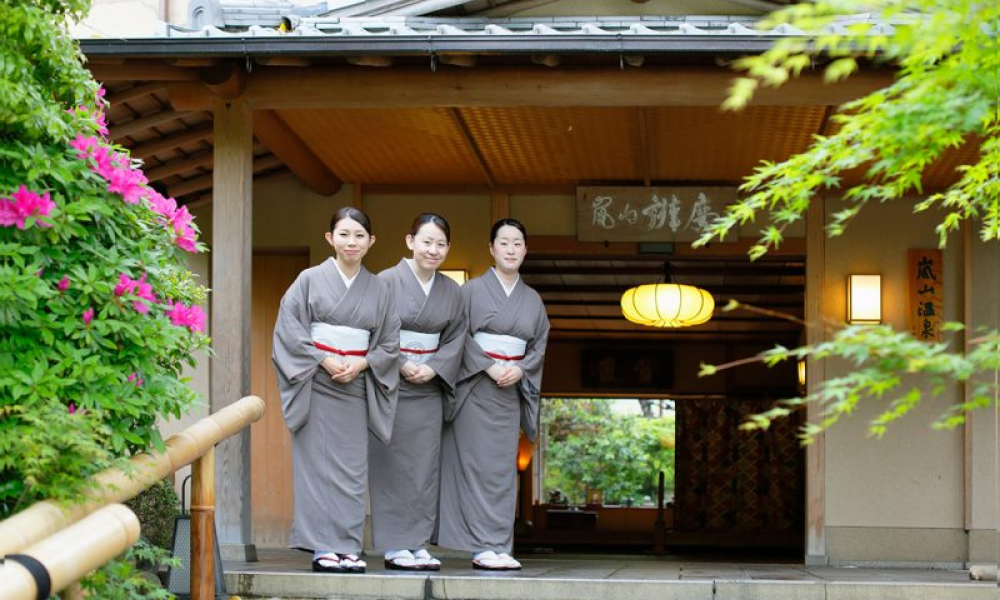
Hospitality also shares the aspect of providing service with consideration and thoughtfulness for the other person, but Omotenashi is a more personal concept unique to Japan, based on a deeper understanding and empathy for the other person. While Western hospitality may sometimes focus on formal etiquette and manualized responses, Omotenashi is characterized by a more heartfelt and flexible response.
For example, offering a warm oshibori at a restaurant is a simple service, but elevating it to Omotenashi involves changing the temperature according to the season or adding a word like “otsukaresama desu” (thank you for your hard work). Also, the absence of tipping in Japan shows that Omotenashi is a pure act that does not seek reward.
| Concept | Omotenashi (Japan) | Service (Western) | Hospitality (Western) |
| Origin | Japan | Western | Western |
| Main Motivation | Selfless consideration | Responding to customer needs | Kindness, thoughtfulness |
| Expectation of Return | Generally none | Often present | Sometimes none |
| Focus | Anticipating needs, creating comfort | Efficiency, fulfilling requests | Comfort, care |
| Delicacy | Very delicate | Relatively direct | Various |
| Relationship | Equal/Respectful | Provider-Customer | Caregiver-Care Recipient |
New Developments in Omotenashi in Modern Lifestyles and Business
In modern society, the spirit of Omotenashi is inherited and is showing new developments in various forms. With the advancement of technology, there are also attempts to provide more personalized Omotenashi by utilizing customer data. For example, analyzing customers’ purchase history and preferences to suggest products and services that match individual needs is playing an important role in enhancing customer satisfaction.
At the same time, there’s growing recognition of the need for employees to respond with flexibility and sincerity, rather than relying solely on standardized manuals. In today’s increasingly globalized world, Omotenashi must extend to people from diverse cultural and religious backgrounds, including international tourists.
This means understanding and respecting each guest’s customs and values, and offering thoughtful, tailored service. For instance, restaurants are expected to check in advance for food allergies or dietary restrictions and to prepare alternative menu options accordingly.

Furthermore, how to practice the spirit of Omotenashi while addressing the challenges facing modern society, such as counter-terrorism measures and environmental issues, will be an important issue for the future.
The spirit of Omotenashi is not just a temporary trend but an irreplaceable value cultivated in the history and culture of Japan. Its essence lies in selfless sincerity, deep consideration for others, and meticulous attention to detail according to the situation.
Rikyu Seven Rules and Their Relevance to Omotenashi
| Rikyu Seven Rules (Japanese) | Rikyu Seven Rules (English Translation) | Relevance to Omotenashi |
| 一則 茶は服のよきように点て | Rule 1: Prepare tea to be delicious for the guest | Shows consideration for the other person’s situation and preferences, preparing tea in a way that is most enjoyable for them. |
| 二則 炭は湯の沸くように置き | Rule 2: Arrange charcoal so the water boils well | Indicates the importance of not neglecting proper preparation and creating the best conditions for the guest. |
| 三則 夏は涼しく冬暖かに | Rule 3: In summer, make it cool; in winter, make it warm | Shows consideration for the seasons and arranging the environment so that the guest is always comfortable. |
| 四則 花は野にあるように活け | Rule 4: Arrange flowers as they are in the field | Respects the beauty of nature and creates a space that gives peace to the guest. |
| 五則 刻限は早めに | Rule 5: Be prompt with timing | Shows consideration for the guest by keeping promises and not wasting their time. |
| 六則 降らずとも雨の用意 | Rule 6: Prepare for rain even if it doesn’t seem like it will | Indicates the importance of being fully prepared to respond to unexpected situations for the sake of the guest. |
| 七則 相客に心せよ | Rule 7: Be considerate of fellow guests | Shows the spirit of valuing harmony by being mindful so that everyone present can spend their time comfortably. |
What did you think? You might even find the spirit of Omotenashi subtly expressed in Japanese anime. From the characters’ thoughtful gestures to the beauty and cleanliness of the Japanese settings depicted, you can probably sense the essence of Omotenashi in various places.
We hope this article has given you a glimpse into the heart of Omotenashi.










